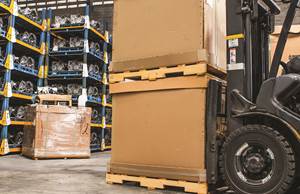Disruptive Technologies to Have Significant Impact on Chemical Industry
IHS Markit sees crude oil-to-chemicals and oxidative coupling of methane to olefins as key disruptions to conventional petrochemical production.
New analysis from Houston-based IHS Markit signals the convergence of two significant and revolutionary technological developments in the petrochemical industry: crude oil-to-chemicals (COTC) and oxidative coupling of methane (OCM). The consultant believes the technologies are poised to have a very significant impact on the chemical industry.
Don Bari, v.p. of chemical technology at IHS Markit, notes that disruptive technology development and deployment has been dominant on a global basis in this industry within the last decade. It has been largely driven by the extreme pricing dynamics of the energy industry, translating directly to petrochemical feedstocks; where such new technology has enabled deployers of capital and technology to use low-cost and locally abundant feedstocks.
Bari’s analysis follows a recent announcement by San Francisco-based Siluria Technologies that it has joined forces with Saudi Arabia’s Saudi Aramco Technologies to maximize chemical production. According to Bari, one of the most significantly disruptive technologies or categories of technologies being developed, based on their sheer volume, is crude oil-to-chemicals (COTC).
In effect, these projects merge a refinery and petrochemical plant into one; as such, going beyond the state-of-the-art petrochemical integration by the implementation of new/reconfiguring unit operations into a refinery. The objective is to shift the product slate derived from a barrel of oil to a range of 40% to 80% chemical feedstocks and non-fuel products, up from the traditional range of 15% to 25%, in order to significantly increase the value of crude oil reserves.
As stated by CTO of Saudi Aramco Ahmad Al Khowaiter, “Maximizing the output of high-value chemicals products from our future crude-oil processing projects is one of the key objectives of our downstream technology strategy.”
The Siluria process, which produces olefins directly from natural gas through oxidative coupling of methane (OCM), is expected to further allow Saudi Aramco’s future COTC facilities to create more value by converting very low-value gas—largely methane—into higher-value olefins products, which improves carbon efficiency and increases the volume of the barrel of oil directed to valuable fundamental petrochemicals. Here are notable points made by Bari about Siluria Technologies’s OCM process.
● Siluria’s oxidative coupling of methane converts methane to olefins in the presence of a catalyst in an oxygen-rich environment. The catalyst reaction “diverts” roughly half of the carbon to the undesirable co-products carbon monoxide (CO) and carbon dioxide (CO2), in this highly-exothermic (heat-generating) reaction. Siluria exploits the exotherm by injecting ethane or propane into a second reaction chamber, where the light alkane is thermally cracked to the olefin.
● In addition, to enhance the overall carbon efficiency of the process, a catalytic methanation step is embodied in Siluria’s process. This reaction converts all generated CO and a portion of the CO2 oxidative coupling reaction co-product back to methane by using the hydrogen generated in both the OCM and the ethane/propane-cracking reaction in the post-OCM section of the reactor.
● In fact, the Siluria process design philosophy is all about less total carbon (methane) consumed per unit of light olefins produced, because the process is “indifferent” to methane as a feedstock, or as energy (process utility). Therefore, one would expect that a design philosophy that equates British thermal units (BTU) of energy savings to a reactor-conversion-per-pass percent increase should drive the most optimum overall process design.
● Siluria’s OCM process also delivers significant reduction in carbon emissions over traditional ethylene production processes. An IHS Markit evaluation shows that the Siluria OCM technology is expected to be a net-negative CO2 producer per ton of ethylene/olefins produced because of the heat generation for the OCM exotherm, and methane production (partly) from CO2 is considered in their methodology as an offset to CO2 emissions.
IHS Markit estimates the Siluria OCM process generates negative 1 ton of carbon dioxide emissions equivalents per ton of ethylene produced as compared to the more conventional naphtha-cracking process for converting crude to olefins, which is estimated at greater than 1.4 tons of CO2 produced per ton of ethylene production. This is a significant improvement in carbon emission reduction, while at the same time capturing greater value from the molecules.
How will the Siluria process add to the impact of COTC mega complexes? According to IHS Markit’s technical analysis of a Saudi Aramco type COTC approach, crude oil feedstock will be converted to chemicals at a higher intensity than conventional processes, increasing the yields of crude oil feedstocks converted to chemicals to 72%.
With the recent cooperation announcement by Siluria and Saudi Aramco on the COTC process, IHS Markit speculates that if the methane off-gas and a portion of the ethane in a hydrocracked Arab light crude oil feedstock were to be fed to the Siluria OCM technology, then a net increase of 300,000 to 350,000 m.t. of ethylene and 200,000 to 250,000 m.t per-year of propylene, would be generated based on a 10 million m.t. per year (200,000 barrels per day) of crude feed. With methane valued at $1.25 per MMBTU in the Middle East, the Siluria OCM technology appears to be an attractive approach to enhance the value of a barrel of oil.
Related Content
Automotive Awards Highlight ‘Firsts,’ Emerging Technologies
Annual SPE event recognizes sustainability as a major theme.
Read MoreThe Fantasy and Reality of Raw Material Shelf Life: Part 1
Is a two-year-old hygroscopic resin kept in its original packaging still useful? Let’s try to answer that question and clear up some misconceptions.
Read MoreICIS Launches: Ask ICIS Generative AI Commodities Assistant
Said to be the first of its kind, this AI assistant will enhance access to ICIS’ intelligence and insights for the energy and chemical markets.
Read MoreTracing the History of Polymeric Materials, Part 26: High-Performance Thermoplastics
The majority of the polymers that today we rely on for outstanding performance — such as polysulfone, polyethersulfone, polyphenylsulfone and PPS — were introduced in the period between 1965 and 1985. Here’s how they entered your toolbox of engineering of materials.
Read MoreRead Next
People 4.0 – How to Get Buy-In from Your Staff for Industry 4.0 Systems
Implementing a production monitoring system as the foundation of a ‘smart factory’ is about integrating people with new technology as much as it is about integrating machines and computers. Here are tips from a company that has gone through the process.
Read MoreLead the Conversation, Change the Conversation
Coverage of single-use plastics can be both misleading and demoralizing. Here are 10 tips for changing the perception of the plastics industry at your company and in your community.
Read More
























